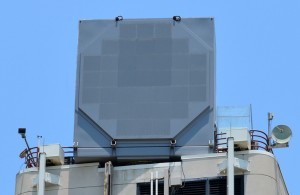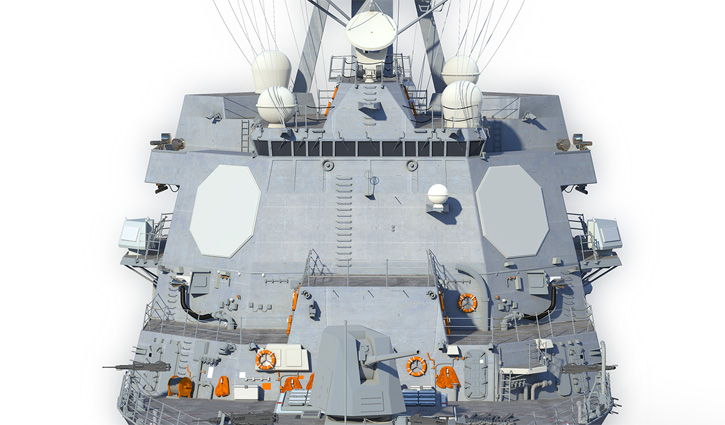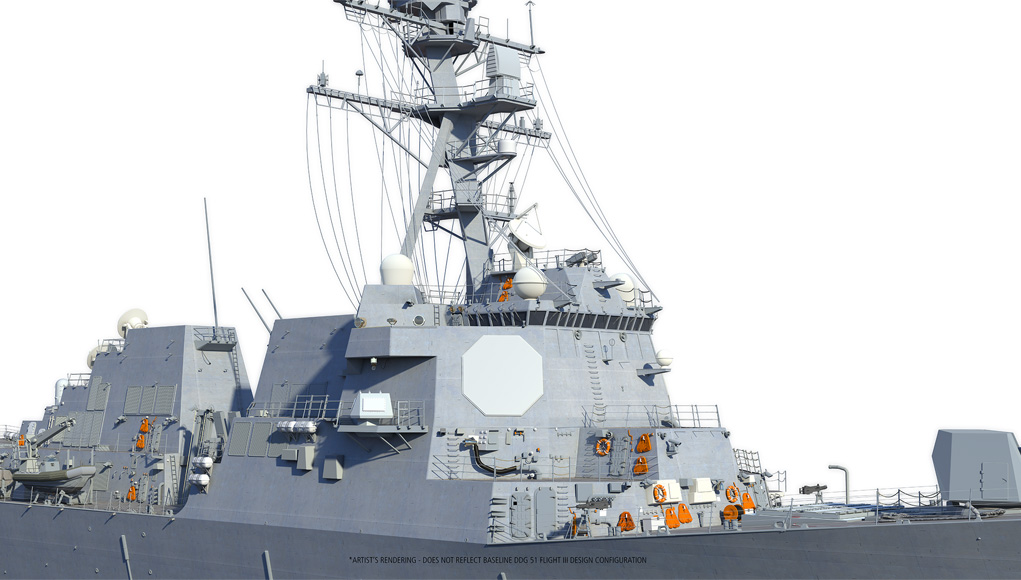
The U.S. Navy and Raytheon Company have completed the critical design review (CDR) of the AN/SPY-6(V) Air and Missile Defense Radar (AMDR). This radar will be installed on US Navy DDG-51 Flight III missile destroyers, improving their fighting and self-defense capabilities. The company said the Engineering and Manufacturing Development (EMD) phase of the program continues and is now more than 40 percent complete.
As a scalable radar, built with Radar Modular Assemblies (RMA) building blocks, AMDR can be grouped to form any size radar aperture, either smaller or larger than currently fielded radars. With much larger arrays, AMDR, is said to be at least 30-times more sensitive than radars configured on existing DDG 51 Arleigh Burke-class destroyers. The new radar can simultaneously handle over 30 times the targets than existing AN/SPY-1D(V), to counter large and complex raids. Using adaptive digital beamforming and reprogrammable radar signal/data processing functionality enables users to rapidly adapt to new missions or emerging threats.
[ismember]The new radar combines S-band and X-band modules, The S-band is supporting a new air and missile defense capability with existing X-band horizon-search radar based technology. The application also includes the Radar Suite Controller (RSC) – a new component to manage radar resources and integrate with the ship’s combat management system.
All supporting infrastructure – cooling, power, command logic and software are scalable, enabling support for multiple types of platforms such as the DDG-1000 or the retrofit of existing DDG 51 destroyers, aircraft carriers, amphibious warfare ships, frigates, or the Littoral Combat Ships, without investing significant radar development costs in each class.

 [/ismember]
[/ismember]
[nonmember] [/nonmember]The RMAs are leveraging Gallium Nitride (GaN) technology to optimize power in a smaller size and using less space, power and cooling than older technology would require for the same performance. The first Engineering Development Model production-representative Radar Modular Assembly (RMA) is currently undergoing testing in the risk-reduction pilot array at the company’s Near Field Range in Sudbury, Mass.
[/nonmember]The RMAs are leveraging Gallium Nitride (GaN) technology to optimize power in a smaller size and using less space, power and cooling than older technology would require for the same performance. The first Engineering Development Model production-representative Radar Modular Assembly (RMA) is currently undergoing testing in the risk-reduction pilot array at the company’s Near Field Range in Sudbury, Mass.
“With customer validation in hand, we will now advance production, driving toward the ultimate – and timely – delivery of this highly capable and much-needed integrated air and missile defense radar capability to the DDG 51 Flight III destroyer.” said Raytheon’s Kevin Peppe, vice president of Integrated Defense Systems’ Seapower Capability Systems business area. The first Flight III ship is scheduled to be the second of two destroyers to be funded in 2016.
[ismember]The team has also delivered the first external combat system interface definition language increment to the Combat System Integration Working Group – the Government-industry team comprised of Raytheon, Navy and Lockheed Martin experts that is focused on AMDR integration with the DDG 51 Flight III’s AEGIS combat system. The Navy plans to upgrade the current AEGIS system to integrate with the new radar, under the ‘Advanced Capabilities Build (ACB)-Next’ development phase.
The CDR assessed all technical aspects of the program, from hardware specifications, software development, risk mitigation and producibility analysis, to program management, test and evaluation schedules, and cost assessments. The review concluded with Navy stakeholders impressed with the radar’s progress to date and confident in the program’s path forward to on-time delivery.
“The outcome confirms Raytheon’s design and technologies as mature, producible and low risk; on track to meet all radar performance requirements, on schedule and within cost.” Raytheon’s announcement said. The company said it has implemented agile development and management methodology throughout the program. This approach supports the ongoing hardware and software design verification, technology maturity, producibility, and risk-reduction imperatives – yielding benefits across all program elements in productivity, quality and affordability.[/ismember] Raytheon is developing the new radar under a $385.7 million cost-plus contract awarded by the Navy in 2013.




















